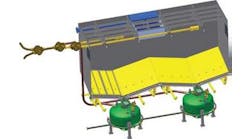A technique to visualize hydraulic fracturing operations has been developed by Guideline Oil Drilling Technology. The company hopes to have a commercial version available by the end of this year, according to CEO Peter Hjorth.
Guideline’s approach involves the use of micro-seismics, which it devised originally as a means to locate the drill bit in real time. During field tests in North America, the company noted its potential for fracturing, and is now developing the two applications in parallel.
Drill bit localization uses seismic waves generated by the friction between the bit and the rock or sand being drilled. With fracturing, the waves are created by stress relief as the rock fractures under the pressure of the fluid and solid material pumped into it under high pressure. In both cases the signals are registered by an array of receivers deployed at the surface above the well.
Guideline has formulated data algorithms to indicate the location of the source of the waves. For drill bit location, there is just one source of events, but in the case of fracturing, there are multiple events at multiple locations.
A feasibility test on a horizontal well in Canada was encouraging, according to chief technology officer Ivo Henriksson. The frac was performed in several zones along the horizontal section of the well at a depth of 5-6,000 ft (1,524-1,829 m), in a hydrocarbon-bearing layer about 30 ft (9 m) thick. Knowing the geology where the test was carried out and the locations where the fracing emanated from, the team concluded that the results were realistic, Henriksson says.
The field’s operator is working “in the dark” for almost all fracturing, he adds, so its only way of judging the effectiveness of a frac operation is the resultant well performance. A means to map the operation will make it possible to assess both the extent and the direction of the fracture. This should allow the operator to improve control of the operation and to judge when it has achieved its aims, making the entire operation more cost-effective.
Henriksson says the technology’s accuracy is sufficient in terms of the deviation on a horizontal plane, although some improvement is required in the vertical plane. A development program which will involve several tests is scheduled for this year in Canada or North America.
Tight reservoirs
The company is encouraged by market prospects. According to market analyst Spears & Associates, the downhole pressure pumping services sector, of which fracturing accounts for the largest part, exhibited compound annual growth of 21% in 1999-2007. In 2007 it was evaluated at about $20 billion.
This reflects the well-known fact that the industry increasingly has to tackle tight reservoirs which restrict hydrocarbon flow. Fracing is widespread in North America, in both vertical and horizontal wells, Henriksson says.
The same development is taking place offshore. In the UK southern gas basin, for instance, several operators have implemented fracturing to improve production. In one recent case it was only after conducting successful frac operations on a field that a leading operator decided that development would be economic.
Taking the Guideline method offshore represents a significant step which the company will consider once the onshore version is commercial. In principle it could be implemented offshore using an array of receivers on the seabed, although like other novel offshore technologies, a higher level of cost will be involved.
Meanwhile the drill bit development is progressing, though at a somewhat slower pace. A number of field tests have been done and more are planned. However, drilling activities have declined in line with the oil price drop, as have the cost of associated services. So for the time being, the company’s business focus will remain on fracturing visualization.
More work also needs to be done on the sensor for the drill bit development, Henriksson adds. Drilling for oil and gas usually involves drilling through sedimentary formations consisting of multiple layers in which seismic waves propagate with different velocities. The sensor, therefore, needs to be able to receive signals imparted with a range of different velocities.
“It’s both a sensor and a mathematical problem. When it comes to hydraulic fracturing, we have pretty much resolved this and arrived at solutions for the algorithms, but there is more to do regarding the drill bit application,” says Henriksson.
Guideline also has become active in a new technology through its acquisition last year of Malå Geoscience, a specialist in ground penetrating radar. This technology also is relevant to the oil and gas industry, Hjorth says. One tool developed and sold by this company is the omnidirectional borehole radar which is deployed downhole to map the surrounding formation.
For more information contact Peter Hjorth, Guideline Oil Drilling Technology. Tel +46 8 655 3641, fax +46 8 655 2610,[email protected], www.guidelinetechnology.com




